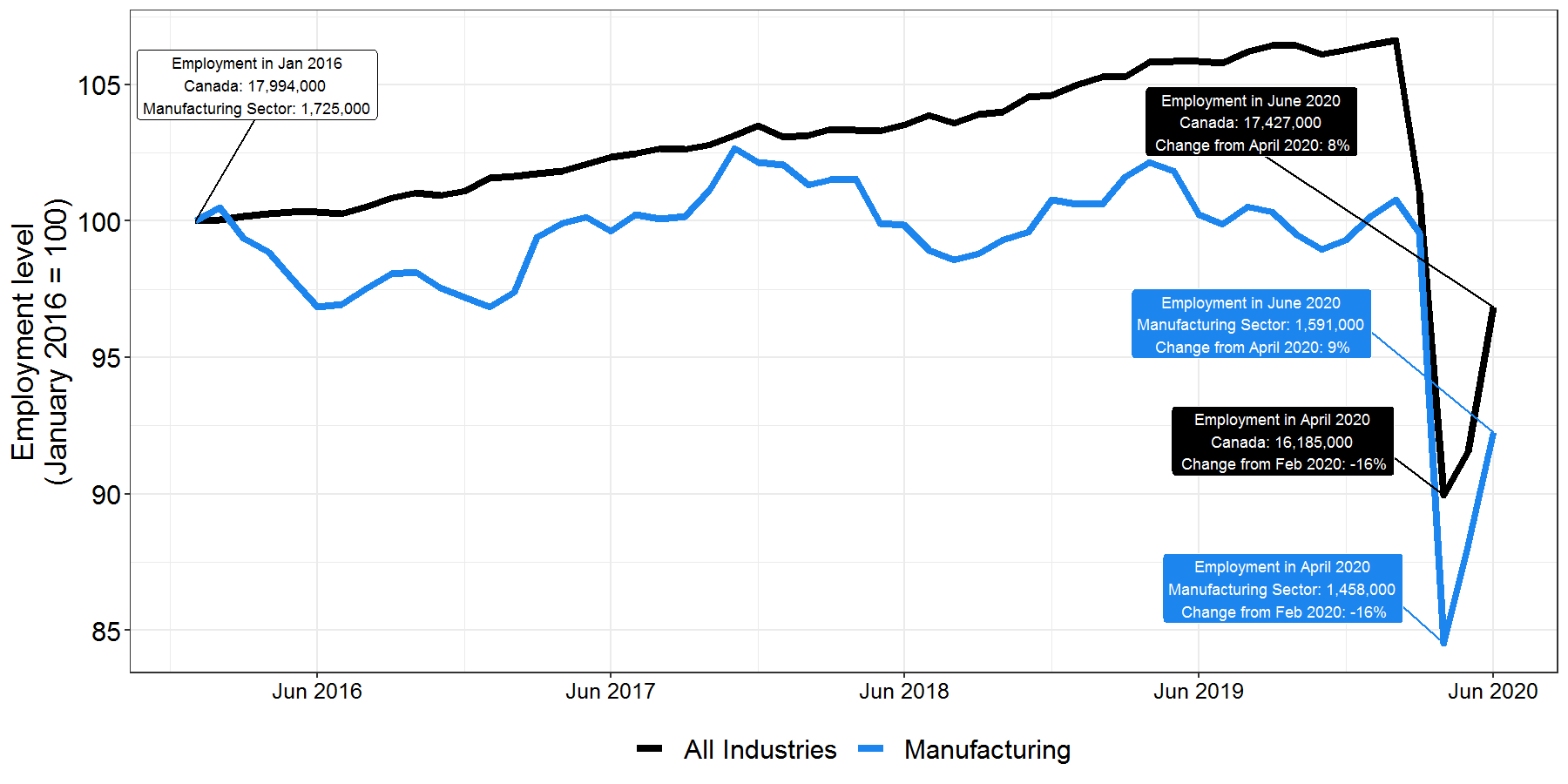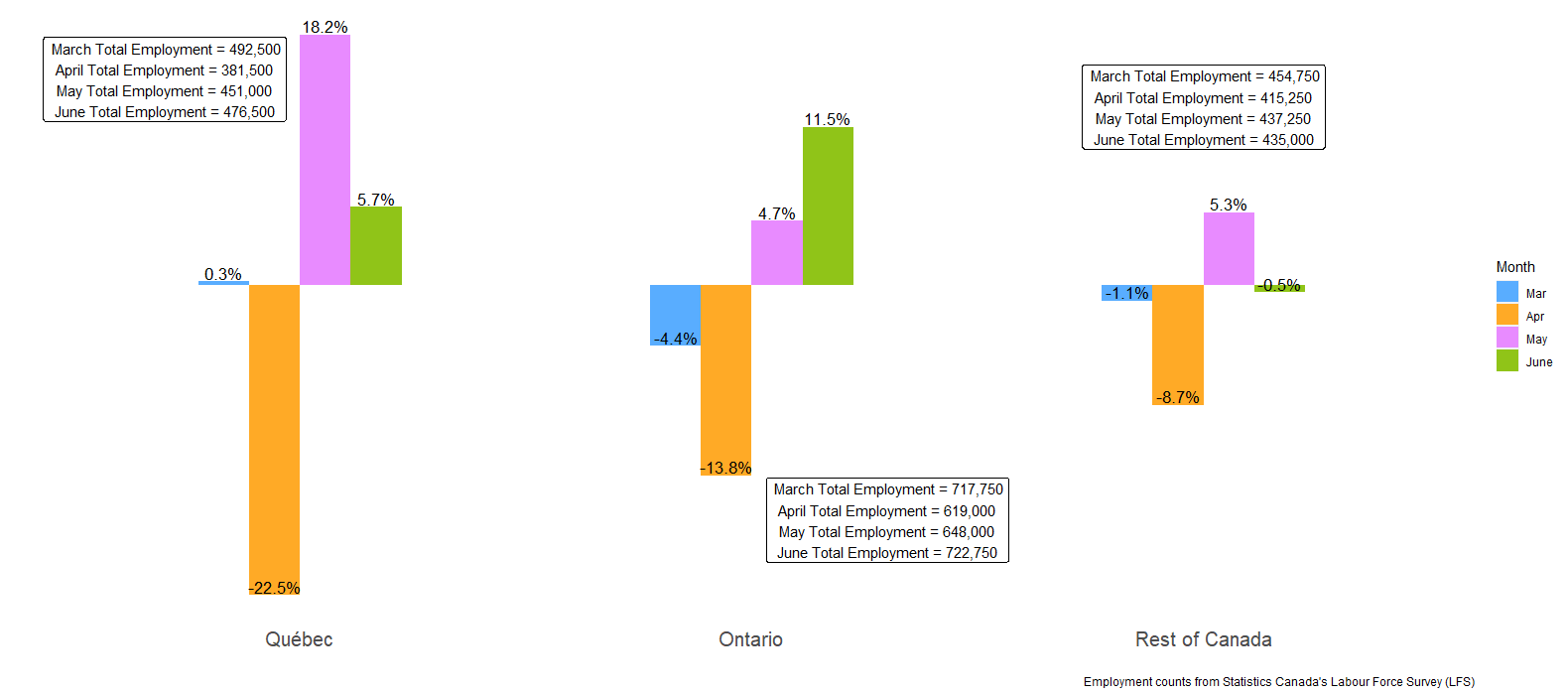Table of Contents
Key Findings
- Between February and April 2020, Canada’s manufacturing sector lost over 280,000 jobs — a 17% drop in employment compared to 16% Canada-wide.
- May and June data from the Labour Force Survey show a rebound since April’s steep decline, with nearly half of manufacturing jobs returning. Nevertheless, the situation remains precarious.
- As the Canadian economy re-opens, a full recovery will depend on the ability of manufacturers to fulfill backlogged and incoming orders, which means securing both supply chains and distribution channels.
- Even before the pandemic, fulfilling orders was a concern for many businesses, as skills shortages and rising costs kept production levels below capacity. New challenges and priorities have emerged, such as staff and customer safety and operational upkeep, compounding previous concerns.
- Access to quality labour market information is critical to help education providers and job seekers identify in-demand skills and other work requirements. As firms shift production and supply chain processes, these requirements will also change.
Introduction
The COVID-19 pandemic and resulting measures to prevent its spread (social distancing, travel restrictions, school and business closures) have led to unprecedented job loss and economic upheaval across Canada. Data from the Labour Force Survey (LFS) confirm that the economic impact of this health crisis affects different sectors in unique ways. Previous LMI Insight Reports have focused on the COVID-19 impacts on the tourism and oil and gas sectors.
This LMI Insight Report focuses on the manufacturing sector (see Box 1), which, prior to the pandemic, already faced workforce shortages and cost-control concerns. As the health crisis began to disrupt supply chains and slow trade, unprecedented job losses created much uncertainty about the future. Now, as restrictions start to lift and the economy reopens, manufacturing firms need quality labour market information (LMI) to develop recovery plans and processes, including identifying available resources and recruiting skilled workers. This LMI will also help the sector address the challenges that preceded the crisis, which remain to be solved.
Box 1: The Manufacturing Sector in Canada
Manufacturing, which includes a wide variety of industries such as food, clothing, and equipment manufacturing to name a few, is a key component of domestic output and overall economic well-being. In Canada, the manufacturing sector provides jobs for over 1.7 million people (9% of the Canadian workforce), comprises more than 10% of Canada’s GDP and accounts for 68% of all of Canada’s merchandise exports.
Manufacturing and COVID-19
In February 2020, 1,740,000 million Canadians worked in the manufacturing sector. By April 2020, employment had crashed to 1,444,000 with the loss of 285,800 jobs (see Figure 1). This represents a 17% drop in employment within about two months compared to a Canada-wide drop of 16% over three months.
These job losses are concerning, especially those related to inventory. Global supply chain disruptions have made it difficult for many industries to acquire the raw materials and other inputs necessary to ensure sufficient inventory to meet customer demand. As the economy starts to re-open and demand picks up, firms unable to fulfill the potential flood of incoming orders may not remain profitable. Similarly, for businesses with high export volumes, international restrictions may affect their ability to deliver goods to customers.
Figure 1: Between February and April 2020, manufacturing lost 285,814 jobs; in May and June, 133,000 jobs returned
Employment levels for the manufacturing sector and Canada from January 2016 through June 2020.

Struggling to Meet Demand in a Pre-COVID World
The emphasis on the capacity to meet customer demand and deliver orders as the economy picks up underscores two related challenges: skills shortages and restricted productive capacities. The sector has been struggling with these issues since long before the pandemic hit.
In spring 2020, the Excellence in Manufacturing Consortium (EMC) — Canada’s largest consortium in the sector — surveyed 769 senior manufacturing executives. Skills shortages emerged as the number one concern that firms were struggling with prior to the COVID-19 outbreak (see Figure 2). Skills shortages can drive up costs, undermine productivity, and erode global competitiveness. They are also difficult to quantify based on national statistics alone.
Overall, as of May 2020, the lack of available candidates with the right skills inhibited manufacturing output by more than 20%, representing $98.4 billion in unfilled orders. Manufacturers had to turn down new orders because they were unable to fill them.
In addition to skills shortages and the resulting productivity constraints, employers in EMC’s survey also pointed to cost control issues — such as payroll, energy, and raw materials — and manufacturing technologies as two other major issues affecting the sector prior to the pandemic.
Figure 2: Skills shortages were the most significant plant management issue for 2020.
Digging Deeper into the Effects of COVID-19
Given the challenges confronting Canadian manufacturers prior to the global health crisis, it is crucial to have a clearer picture of the impact of the pandemic on the sector. This means identifying any new, COVID-19-specific effects as well as determining how COVID-19 will influence the sector’s pre-existing issues.
In another survey conducted by EMC after the pandemic began, 602 manufacturing firms were asked to identify their issues of greatest immediate concern. The results indicate a new, acute set of challenges that have arisen with COVID-19.
Among these new challenges, keeping their staff, management and customers healthy and safe was the most pressing issue. Firms were either extremely or very concerned about this. Their ability to sustain operations, supply chains and their future productive capabilities followed.
These new issues, however, have not supplanted the sector’s pre-COVID-19 challenges. These same manufacturing firms also stated that skills shortages, vacancies, and related human resource issues were among their top priorities; however, they have fallen further down the list. As the economy reopens, these pre-COVID issues still need to be addressed in any recovery plans.
Moving Toward Recovery
As restrictions begin to lift, employment in manufacturing is starting to rebound. In May, 62,200 jobs were regained; in June, another 70,800 returned. The month-over-month relative employment changes in manufacturing are shown by region in Figure 3. From March to April, the largest share of job losses occurred in Quebec with an employment decline of 22.5%; British Columbia, on the other hand, saw the least decline.
Figure 3: Quebec suffered the greatest employment share decline in April 2020 but also showed the greatest rebound in May.
Month-over-month percentage change in total employment in manufacturing.

These trends could partially be explained by each region’s unique concentration of manufacturing employment. Quebec, for instance, has a long-standing history of providing tax incentives to aerospace manufacturers. It continues to house bases of operation for Bombardier, the largest aerospace company in Canada, as well as Pratt & Whitney Canada and Bell Helicopter Textron Canada. Given the travel restrictions enacted to curb the spread of the virus, such large employment declines are not surprising. Similarly, Ontario has the greatest concentration of plastic manufacturing, which is heavily reliant on trade. Again, the economic shutdowns of both Canada and its international trading partners significantly slowed trade and likely contributed to the declines in employment reflected in Figure 3.
The EMC surveys also confirmed that manufacturers across different industries have been impacted unevenly. For example, in the food and beverage industry, manufacturers reported consumer-side sales increases upwards of 30% while their commercial-side sales (e.g., restaurants and public venues) were down significantly. Whether the upside will offset the downside won’t be clear until Q2 and Q3 sales figures are available.
Although the situation remains precarious, recent increases in employment offer a positive sign. Across all regions in Canada, employment in manufacturing increased in May (see Figure 3). In June, manufacturing employment increased for both Quebec and Ontario, but slightly decreased for the rest of Canada. Moreover, just over one quarter (26%) of those firms surveyed by EMC stated that they were in the process of recalling furloughed workers. Most reported that they were returning to full production. Firms also reported using downtime to make skills investments and engage in continuous improvement activities. As in past recessions, these firms will be ahead of those simply waiting for the market to return to “normal.”
Local, Timely, Granular LMI is Key
As the manufacturing sector begins to rebuild its workforce and restore its productive capabilities, employers and job seekers will require access to a wide range of local, timely, granular LMI, especially information related to understanding the “new normal” of a post-COVID economy.
In the acute phase, firms will need information to help them figure out how to maintain and grow their customer bases, re-stabilize their supply chains, and ensure order fulfillment and customer delivery. Insights gained through ongoing assessments — such as EMC’s Pulse surveys, ManufacturingGPS, the LFS and other LMI tools and resources — will be integral.
Looking towards 2021 and beyond, the recurring concern of skills shortages will likely affect the rate of industry recovery. Clearly identifying and communicating the job skills and other work requirements of the sector will be key. This will enable educators, career counsellors and job seekers to better understand these work requirements and to develop and invest in the right skills training.
To this end, LMIC is working to improve the availability of and access to skills and other job requirements information. For example, LMIC has partnered with Vicinity Jobs — a Canadian-based big data and analytics firm — to create an online tool that analyzes work requirements collected from millions of online job postings (available this month).
In addition, LMIC is working with Employment and Social Development Canada (ESDC) and Statistics Canada to link the skill requirements of jobs to ESDC’s new Skills and Competency Taxonomy through web scraping and correspondence tables to the US Occupational Information Network (O*NET). Of course, much more work remains. Close co-operation and continued dialogue between the sector and training providers — a central role of EMC — will be essential to validate these insights to address skills shortages in manufacturing.
The Way Forward
The economic shutdown from the COVID-19 pandemic hit Canada’s manufacturing sector hard. While employment declines were unprecedented, the sector is starting to show signs of recovery as restrictions begin to lift. The pandemic, however, has created new concerns and challenges for a sector that was already struggling with restricted productive capacities from skills shortages.
As the sector adjusts to a new normal post-COVID, local, timely, granular LMI will be required in the rebuilding process. Specifically, firms will need information to help them 1) maintain and grow their customer base and sales, 2) secure a stable supply chain, 3) ensure competitive staffing levels and a skilled workforce supply, 4) restore productivity systems and processes, and 5) implement health and safety protocols for reopening.
Acknowledgments
This LMI Insight Report was jointly prepared by the Excellence in Manufacturing Consortium (Scott McNeil-Smith and Jean-Pierre Giroux) and the staff of the Labour Market Information Council (Anthony Mantione). Your feedback is welcome. We invite you to provide your input and views on this subject by emailing us at info@lmic-cimt.ca.
